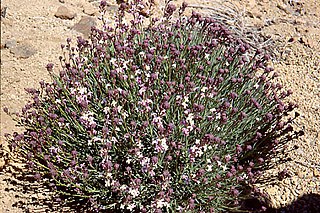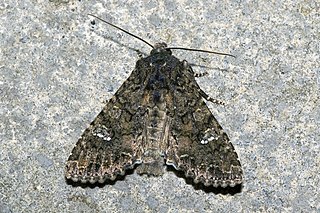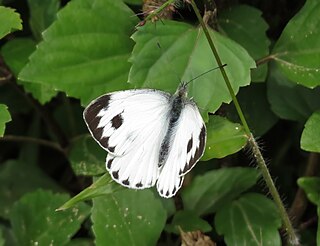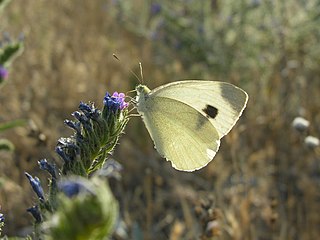
Brassicaceae or Cruciferae is a medium-sized and economically important family of flowering plants commonly known as the mustards, the crucifers, or the cabbage family. Most are herbaceous plants, some shrubs, with simple, although sometimes deeply incised, alternatingly set leaves without stipules or in leaf rosettes, with terminal inflorescences without bracts, containing flowers with four free sepals, four free alternating petals, two short and four longer free stamens, and a fruit with seeds in rows, divided by a thin wall.

Erysimum, or wallflower, is a genus of flowering plants in the cabbage family, Brassicaceae. It includes more than 150 species, both popular garden plants and many wild forms. The genus Cheiranthus is sometimes included here in whole or in part. Erysimum has since the early 21st century been ascribed to a monogeneric cruciferous tribe, Erysimeae, characterised by sessile, stellate (star-shaped) and/or malpighiaceous (two-sided) trichomes, yellow to orange flowers and multiseeded siliques.

The green-veined white is a butterfly of the family Pieridae.

The Pieridae are a large family of butterflies with about 76 genera containing about 1,100 species, mostly from tropical Africa and tropical Asia with some varieties in the more northern regions of North America. Most pierid butterflies are white, yellow, or orange in coloration, often with black spots. The pigments that give the distinct coloring to these butterflies are derived from waste products in the body and are a characteristic of this family. The family was created by William John Swainson in 1820.

Pieris rapae is a small- to medium-sized butterfly species of the whites-and-yellows family Pieridae. It is known in Europe as the small white or small cabbage white, in North America as the cabbage white or cabbage butterfly, and in New Zealand simply as white butterfly. The butterfly is recognizable by its white color with small black dots on its wings, and it can be distinguished from P. brassicae by the smaller size and lack of the black band at the tip of their forewings.

Pieris brassicae, the large white, also called cabbage butterfly, cabbage white, cabbage moth (erroneously), or in India the large cabbage white, is a butterfly in the family Pieridae. It is a close relative of the small white, Pieris rapae.

Pieris, the whites or garden whites, is a widespread now almost cosmopolitan genus of butterflies of the family Pieridae. The highest species diversity is in the Palearctic, with a higher diversity in Europe and eastern North America than the similar and closely related Pontia. The females of many Pieris butterflies are UV reflecting, while the male wings are strongly UV absorbing due to pigments in the scales.
White butterfly may refer to:
The term cabbage worm is primarily used for any of four kinds of lepidopteran whose larvae feed on cabbages and other cole crops. Host plants include broccoli, cauliflower, Brussels sprouts, collards, kale, mustard greens, turnip greens, radishes, turnips, rutabagas and kohlrabi. This small group of similar pest species is known to agriculturists as the cabbage worm compte butterflies.

The cabbage moth is primarily known as a pest that is responsible for severe crop damage of a wide variety of plant species. The common name, cabbage moth, is a misnomer as the species feeds on many fruits, vegetables, and crops in the genus Brassica. Other notable host plants include tobacco, sunflower, and tomato, making this pest species particularly economically damaging.

Pieris canidia, the Indian cabbage white, is a butterfly in the family Pieridae found in India, Nepal and Indochina. Pieris rapae is one of the most closely related species in the Pieridae.

Pontia callidice, the lofty Bath white or peak white, is a small butterfly of the family Pieridae, that is, the yellows and whites, which occurs in the Palearctic zoogeographical region.

Pontia protodice, the checkered white or southern cabbage butterfly, is a common North American butterfly in the family Pieridae. Its green larva is a type of cabbage worm.

Pieris mannii is a butterfly in the family Pieridae.
Butterflies, or members of the Papilionoidea superfamily, use two ultraviolet signals, UV reflectance or absorbance as a communication system. The ultraviolet region is the part of the electromagnetic spectrum between 10 nm and 400 nm in wavelength. Sensitivity to this region provides butterflies several benefits such as nectar guides for nectar, but it also provides a private communication channel unavailable to predators. With this secure line, butterflies are able to facilitate mating behavior and sex recognition.

Dixeia, commonly called the small whites, is a genus of butterflies of the subfamily Pierini in the family Pieridae that are found mainly in Africa.
This page is based on this
Wikipedia article Text is available under the
CC BY-SA 4.0 license; additional terms may apply.
Images, videos and audio are available under their respective licenses.












